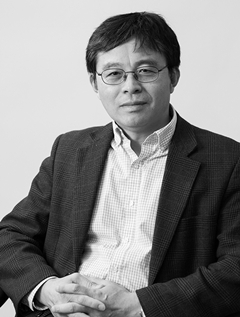Prof. Xiaoyang Zhu: Polarons, Polaritons, and the Perovskite Puzzle (2016/12/01) |
| ( 2016-11-08 ) |
|
题目 |
Polarons, Polaritons, and the Perovskite Puzzle |
|
报告人 |
Prof. Xiaoyang Zhu
Columbia University
|
 |
|
时间 |
2016年12月1日(星期四)下午3:00 |
|
地点 |
微尺度国家实验室9004会议室 |
| 报告人简介 |
Prof. Zhu received his B.S. degree in Chemistry from the Fudan University in 1984, and a Ph.D. at the University of Texas, Austin in 1989. In the years 1990-1992 and 1992-1993, Zhu worked as a postdoc fellow at University of Texas, Austin and Fritz-Haber-Institute, Berlin. In 1993, he became an assistant professor of chemistry in Southern Illinois University, Carbondale. In 1997 he moved to University of Minnesota as an associate and then full professor. In 2009 he moved back to University of Texas at Austin where he served as the director of DOE Energy Frontier Research Center at UT Austin and Center for Materials Chemistry. In 2013, he joined Columbia University as a professor of Chemistry. He was selected to be the fellow of the American Physical Society in 2011. Prof. Zhu is interested in light-matter interaction, with a particular focus on many-body interactions such as polaron formation, exciton fission, and Auger recombination. |
|
报告摘要 |
The feverish research activity on lead halide perovskites has been fueled by their exceptional optoelectronic properties, e.g., in solar cells and light-emitting devices. Hybrid lead halide perovskites exhibit carrier properties that resemble those of pristine nonpolar semiconductors despite static and dynamic disorder, but how carriers are protected from efficient scattering with charged defects and optical phonons is unknown. We have recently put forward the large polaron model to explain the carrier protection and have found experimental support to this proposal. We probe the mechanism of charge carrier protection in hybrid perovskites using femtosecond time-resolved photoemission, time-resolved photoluminescence, and nonlinear optical spectroscopies. We find that nascent charge carriers are screened by “solvation” or large-polaron formation on time scales ≤ 250 fs, leading to protected carriers with dramatic suppression of electron- LO phonon scattering. This results in long-lived energetic electrons with excess energy ~ 0.25 eV above the conduction band minimum and with lifetime on the order of 100 ps, which is ≥103 time longer than those in conventional semiconductors. The exceptionally long-lived energetic carriers lead to hot fluorescence emission on the ~100-200 ps time scale. The protection of energetic carriers is directly correlated with the liquid-like reorientational motion of organic cations, as revealed in nonlinear optical spectroscopy. The formation of protected energetic carriers requires the competitive ultrafast dynamics of large-polaron formation in the dynamically disordered hybrid perovskite structure. In contrast to that of energetic carriers, the protection of long-lived bandedge carriers do not require the presence of organic cations and is an intrinsic property of the soft perovskite lattice. Finally, we will discuss strong light-matter interaction leading to efficient exciton-polariton formation and our most recent observation of coherent light emission without population inversion; this is distinctively different than our earlier findings of efficient lasing in these materials. | |
|
|
